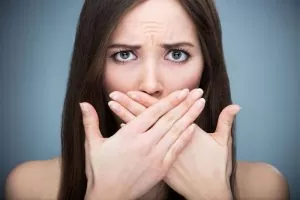Plaque is a colourless, soft and sticky film which builds up on the outside of teeth and also along the gums. It harbours hordes of germs which multiplies at an alarming rate and reside in your mouth. Plaque build-up if not removed, will harden and turn into a yellow brown matter called tartar. Some kinds of plaque may cause dental decay and some causes gum diseases. Plaque is colourless and therefore not noticed easily unless it turns into tartar.
How is plaque created?
When we eat, our food starts digesting in the mouth itself. Our saliva contains enzymes which break down food into carbohydrates. This carbohydrate is further turns into sugar by further processes. The bacteria present in the mouth breaks down the sugar left on teeth and in the mouth and turn it into acid. This acid along with saliva mixes with food remnants in mouth and creates plaque. This thin film coats your teeth and sticks at the base of the teeth. It may also stick to fillings or any other dental work. If this film is not removed every day with brushing and flossing it will ruin your dental health and you may end up with tons of dental work.
How to get rid of plaque
It was believed that as we grow older our teeth give way and get dental decay which will end in tooth lost. One by one we may lose all teeth and we may have to wear dentures for the rest of our lives. But now with the increased dental health awareness and better opportunities to seek dental health care and remedies, we know better. Because of the sustained efforts of the state and better information, we know how we can take care of our teeth and prevent teeth loss.
Dental plaque is the beginning of tooth decay and ultimate loss. We should try to stop dental plaque from forming on our teeth and gums.
It requires simple steps, which consists of healthy dental care routine from childhood and visiting your dentist regularly so that dental problems can be nipped in bud before it becomes too big to lead to dental loss.
One way of knowing whether you are following proper dental care routine is to check for plaque in your mouth by chewing coloured bubble gum which will stain the plaque and you will know whether there is plaque build-up in your mouth.
The first step for removing plaque is to visit your dentist and ask for guidance in removing plaque. If the plaque has turned into tartar, your dentist will suggest removing it with the help of special instruments.
After the tartar has been removed you need to see to it that your teeth and gums remain plaque free.
Flossing for dental hygiene
Flossing is extremely important for proper dental hygiene. It is advised that you should floss your teeth at least once a day. Flossing removes food particles which get stuck between the teeth and do not get out while brushing.
The floss is a thin string which has to be held between pointer fingers of both hands and drawing the string in between spaces of teeth. This exercise has to be done for both upper and lower teeth. Ease the string slowly and do not use force if the string does not move. If you use force ion the string your gums may get harmed.
Floss is easily available at every chemist. If you do not know how to use floss, get your dentist’s help. If flossing is done before brushing, it will help cleaning all debris from the mouth while brushing and rinsing the mouth. It is advisable to floss first before brushing.
Brushing
Brushing teeth at least twice a day is very important to stop the build-up of plaque.
Use a toothbrush which is comfortable on your teeth. It should not be too hard or too soft. Ask your dentist to show you the movement of how you should use your toothbrush.
Make a slightly short and circular movement on your teeth but do not brush from downward to upward. It will harm your gums. Rinse well. While brushing remember to reach the back of upper teeth because it gets neglected when we brush in a hurry. Make it a point to brush upper and lower front and back teeth. Pay attention to upper back molars. Start with brushing upper back molars and then brush upper front teeth. Then come down to lower back molars and then to lower front.
Manual toothbrushes work well for most people, but electric tooth brushes with oscillating heads make circular movements which is beneficial to clean most areas in the mouth. Rinsing the mouth after flossing and brushing with a mouthwash will give a fresh feeling in the mouth as well as stops the bacterial growth when the mouth is not active during sleep.
Cleaning the tongue
Use a tongue cleaner to clean your tongue. Tongue also harbours plaque and bacteria. It is important to get rid of a white film from the tongue which leads to tooth decay. Tongue is a rough surface unlike teeth which have a smooth surface because of enamel. Sugar particles stick to tongue and breed bacteria. Some people use dental pick which a thin plastic string strung between two ends which also helps in quickly removing food particles stuck between teeth.
Fluoride
Using a fluoride tooth paste is very important because many water bodies in towns may not have natural fluoride in them. The body needs fluoride to nourishment of teeth in addition to other needs.
Basically, a regular and consistent dental care routine will help keep your teeth healthy and clean. Remember to visit your dentist at least once in 6 months for a thorough cleaning as well.




